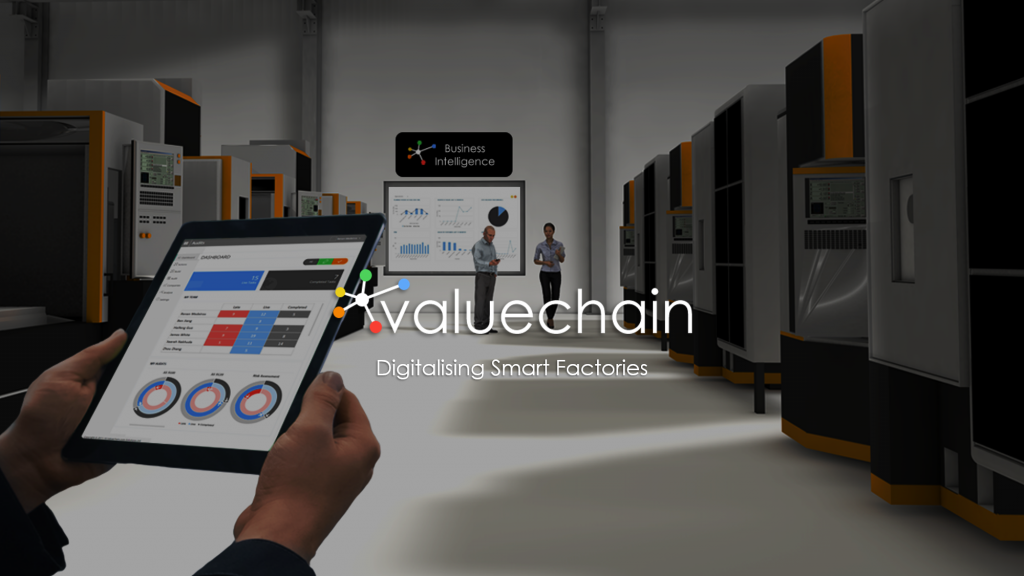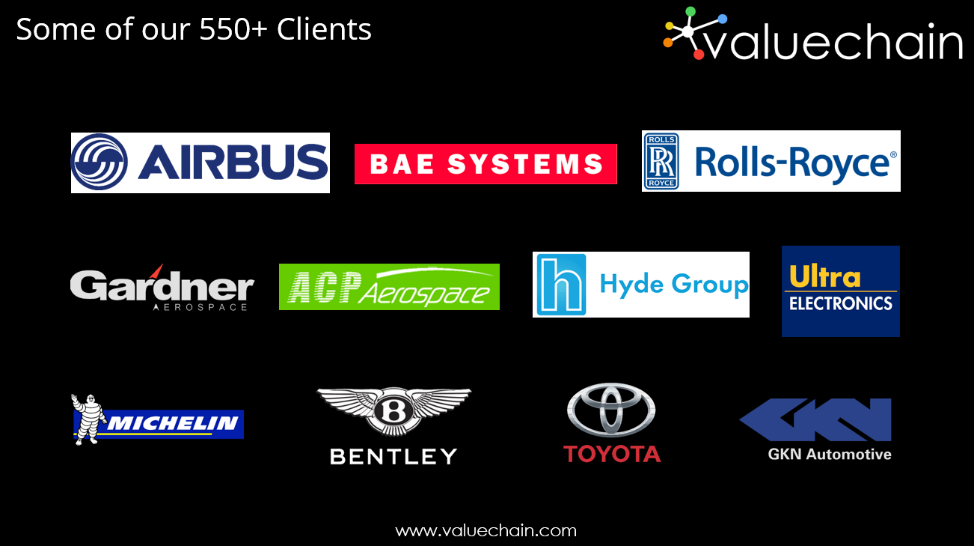
“Valuechain Technologies is a global enterprise software business which provides modular ERP solutions for advanced manufacturing sectors, and supply chain intelligence solutions. Focusing on niche processes such as additive manufacturing, Valuechain’s modular ERP integrates CRM, compliance auditing, data capture, advanced reporting, NPI and supplier portals to digital business processes to improve productivity. Valuechain’s supply chain intelligence applications include supply chain performance management, multi-tier supply chain mapping, and supplier / customer portals. Designed by Valuechain’s leadership team, with over 100 years’ experience owning and running advanced manufacturing companies, Valuechain’s solutions are developed in collaboration with our 500+ SME clients and leading manufacturing companies including Airbus, Bentley Motors and Rolls-Royce, to provide scalable solutions for companies of all sizes.”

“The ability to visualise products and processes in a virtual environment can reduce waste significantly by accelerating technical problem solving and knowledge transfer through lower risk prototypes and simulated pilots. This compresses new product introduction and enables businesses to engage stakeholders prior to major investments in people, product, plant, processes and systems which not only mitigates risk but also reduces quality non-conformances, costs and drives on-time in full delivery.”
“The priority must be to create capacity for change which for many companies is about streamlining data capture and removing waste caused by fragmented systems and processes. It is important to understand current performance measures and prioritise improvement areas with tangible success criteria. Through digital production control, work flow and business intelligence solutions such as Valuechain’s solutions it is then possible to do more with less and operate smarter by providing key personnel with reliable business intelligence to make informed decisions. Too many businesses focus on historic KPIs ie. what happened, rather than focusing on why things are happening and what is likely to happen, it is therefore critical to capture diagnostic analytics to capture risks and lessons learned to embed corporate learning that can underpin AI driven predictive analytics.”

“We have either a complete end to end MRP solution including our AM TRACE module, which will handle the whole of life production and sub con / post processes operations from estimating through to invoice or alternatively the AM TRACE module is available as a bolt on “app” for existing and legacy MRP ERP or MES solutions. We also currently have two versions of this, AeroDNAam DNAam and new this year is our DNAam Start-Up Program to assist smaller SME companies enter the AM sector.”

“DNAam was designed for AS9100 Aerospace manufacturing initially but since its launch at Paris Air Show in 2017 with the backing of our first clients and innovation partners AIRBUS and Zenith Tecnica in New Zealand. However not surprisingly the unique and dynamic TRACE solution for materials and consumables associated with the manufacturing process has attracted interest from the Medical Automotive and Heavy industries also such as shipbuilding along with Oil & Gas. That will only continue to grow for us.:
“Highly regulated sectors such as aerospace and automotive require end-to-end traceability to ensure accountability for compliance throughout the product lifecycle. Additive manufacturing offers significant opportunities to optimise raw material usage but only if unused powders and materials can be recycled. However scaling up traceability for all recycled and blended AM material batches has prior to DNAam has been complex, manual and prone to human error.”
Visual Stock management tool: DNAam’s visual stock location management Drag and drop Gins between locations as they progress along the production process, from Goods In to Powder Storage, to Machining to Blend area. Any time you move a Gin, a record is automatically recorded of who moved what, when, and to where; so you have complete audit traceability.
- Configurable chemical elements for each material , to store sample results.
- Graded material control.
- Detail production data capture forms (iQapture)
- Visual AM-Trace tool: Two major challenges of implementing AM parts in aviation are traceability of the powder and achieving repeatability in the process to standardise it. The trace tool allows us visualise every build in which a batch of powder has been used by clicking on it. This intuitive tool provides complete traceability which can be used to scale-up AM production, not only in aerospace but in all types of industries.
“DNAam has been innovated in collaboration with some of the world’s leading advanced manufacturing companies such as Airbus, to embed best practice, scalable AM business processes and capture AM business intelligence. As a modular solution DNA.am can work alongside existing ERP solutions for primes and tier 1’s, or as a cost-effective turnkey ERP system from quotation through to invoicing for smaller AM businesses or even start-up AM bureaus.”
Subscribe to Our Email Newsletter
Stay up-to-date on all the latest news from the 3D printing industry and receive information and offers from third party vendors.
You May Also Like
3D Printing Financials: Fathom Struggles in Financial Quicksand During Critical Transition
Facing a year of key transitions and financial pressures, Fathom (Nasdaq: FTHM) has filed its annual report for 2023 with the U.S. Securities and Exchange Commission (SEC). The document outlines...
Latest Earnings Overview for Australian 3D Printing Firms Titomic and AML3D
Australian 3D printing manufacturing firms Titomic (ASX: TTT) and AML3D (ASX: AL3) reported their financial results for the period from July to December 2023, marking the first half of their...
3D Printing Webinar and Event Roundup: April 7, 2024
Webinars and events in the 3D printing industry are picking back up this week! Sea-Air-Space is coming to Maryland, and SAE International is sponsoring a 3D Systems webinar about 3D...
3D Printing Financials: Unpacking Farsoon and BLT’s 2023 Performance
In the Chinese 3D printing industry, two companies, Farsoon (SHA: 688433) and Bright Laser Technologies, or BLT (SHA: 688333), have recently unveiled their full-year earnings for 2023. Farsoon reported increases...































